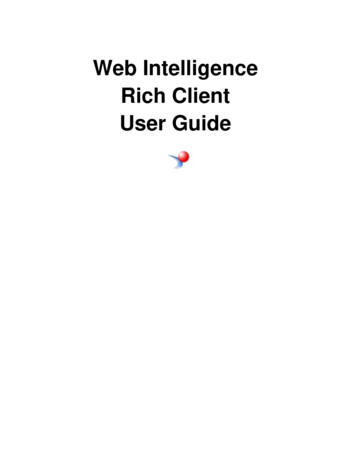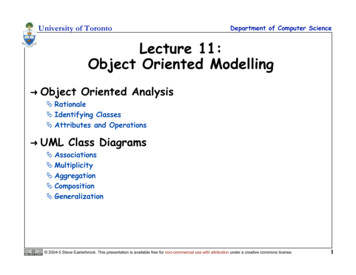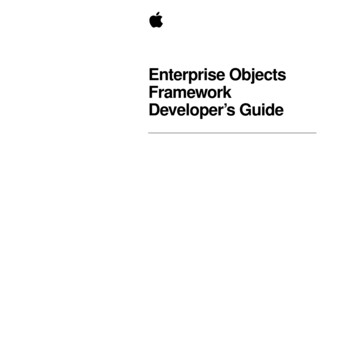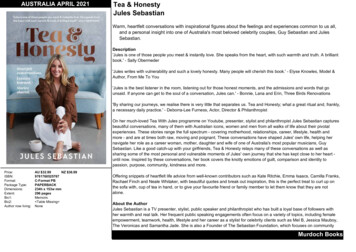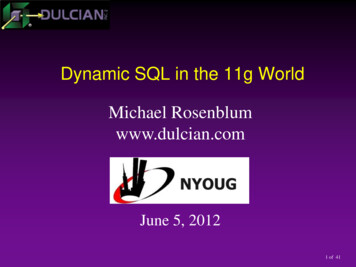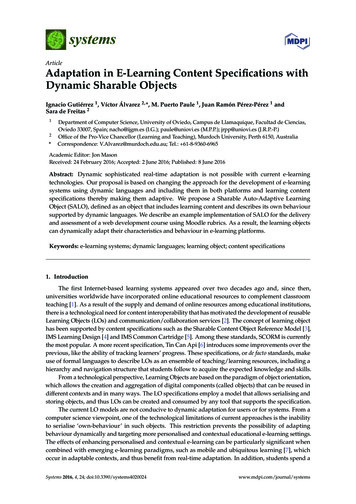
Transcription
systemsArticleAdaptation in E-Learning Content Specifications withDynamic Sharable ObjectsIgnacio Gutiérrez 1 , Víctor Álvarez 2, *, M. Puerto Paule 1 , Juan Ramón Pérez-Pérez 1 andSara de Freitas 212*Department of Computer Science, University of Oviedo, Campus de Llamaquique, Facultad de Ciencias,Oviedo 33007, Spain; nacho@ijgm.es (I.G.); paule@uniovi.es (M.P.P.); jrpp@uniovi.es (J.R.P.-P.)Office of the Pro-Vice Chancellor (Learning and Teaching), Murdoch University, Perth 6150, AustraliaCorrespondence: V.Alvarez@murdoch.edu.au; Tel.: 61-8-9360-6965Academic Editor: Jon MasonReceived: 24 February 2016; Accepted: 2 June 2016; Published: 8 June 2016Abstract: Dynamic sophisticated real-time adaptation is not possible with current e-learningtechnologies. Our proposal is based on changing the approach for the development of e-learningsystems using dynamic languages and including them in both platforms and learning contentspecifications thereby making them adaptive. We propose a Sharable Auto-Adaptive LearningObject (SALO), defined as an object that includes learning content and describes its own behavioursupported by dynamic languages. We describe an example implementation of SALO for the deliveryand assessment of a web development course using Moodle rubrics. As a result, the learning objectscan dynamically adapt their characteristics and behaviour in e-learning platforms.Keywords: e-learning systems; dynamic languages; learning object; content specifications1. IntroductionThe first Internet-based learning systems appeared over two decades ago and, since then,universities worldwide have incorporated online educational resources to complement classroomteaching [1]. As a result of the supply and demand of online resources among educational institutions,there is a technological need for content interoperability that has motivated the development of reusableLearning Objects (LOs) and communication/collaboration services [2]. The concept of learning objecthas been supported by content specifications such as the Sharable Content Object Reference Model [3],IMS Learning Design [4] and IMS Common Cartridge [5]. Among these standards, SCORM is currentlythe most popular. A more recent specification, Tin Can Api [6] introduces some improvements over theprevious, like the ability of tracking learners’ progress. These specifications, or de facto standards, makeuse of formal languages to describe LOs as an ensemble of teaching/learning resources, including ahierarchy and navigation structure that students follow to acquire the expected knowledge and skills.From a technological perspective, Learning Objects are based on the paradigm of object orientation,which allows the creation and aggregation of digital components (called objects) that can be reused indifferent contexts and in many ways. The LO specifications employ a model that allows serialising andstoring objects, and thus LOs can be created and consumed by any tool that supports the specification.The current LO models are not conducive to dynamic adaptation for users or for systems. From acomputer science viewpoint, one of the technological limitations of current approaches is the inabilityto serialise ‘own-behaviour’ in such objects. This restriction prevents the possibility of adaptingbehaviour dynamically and targeting more personalised and contextual educational e-learning settings.The effects of enhancing personalised and contextual e-learning can be particularly significant whencombined with emerging e-learning paradigms, such as mobile and ubiquitous learning [7], whichoccur in adaptable contexts, and thus benefit from real-time adaptation. In addition, students spend aSystems 2016, 4, 24; tems
Systems 2016, 4, 242 of 11significant amount of time searching for online information to acquire knowledge and skills. This taskof selecting the most relevant information can be cognitively very demanding and cause students tostress and have a negative effect on students’ engagement and attrition. One way to help studentsto engage with online learning is to make the systems sensitive to the needs and context of the user.Recent research shows that the effectiveness of adaptive learning increases when the systems introducemechanisms allowing for learner control [8,9].Traditional online educational systems have either none or statically implemented adaptation,such as the case of conditional activities and groups/roles customisation in Moodle [10]. In order toaddress this gap, this paper introduces the creation of learning objects that can dynamically adapt theirbehaviour in addition to being interoperable across platforms. We have designed and implementedwhat we call a SALO (Sharable self-Adaptive Learning Object) [11] that is fully autonomous and ableto express its content and adaptive behaviour so that it can be shared between different LearningManagement Systems (LMSs).Creating SALOs adds a level of difficulty, as it requires technical knowledge, but in our view thiscan be compensated by advantages in re-using the object across different units. Under this approachthe LO becomes completely independent and from a technical point of view we can speak of “classless”objects, each one unique and able to behave self-sufficiently. We achieve this goal by using dynamiclanguages that enable storing objects’ behaviour in a simple manner. The flexibility of dynamiclanguages allows us to generate objects that are “free” from their classes, can experience changes andare dynamically adaptable to the context in which they run.2. Background2.1. Adaptive Educational SystemsIt is crucial for teaching and learning processes that systems manage information according to theneeds and context of each individual student. To this end, adaptive educational hypermedia (AEH)include the variables and a user model to adapt system navigation and content, goals, knowledgelevel, background, interests, preferences, stereotypes and cognitive preferences [12]. The user modelcan contain behavioural, cognitive and affective data [13]. Adaptive systems can also include an expertand domain models, indicating the content and knowledge to be taught and relationships betweendomain elements [14].AEH relies on the use of methods and techniques of adaptive hypermedia [15] to includeadaptation in educational systems. Approaches to achieve this goal include: using sets of rules,proprietary objects and closed formats that belong to the application and the introduction of newlanguages for the definition and creation of adaptive processes [16–18].Among the previous approaches, the use of rules provides relatively simple and direct ways toachieve system adaptation; however, the resulting adaptation cannot be used by other systems. Withregards to the creation of proprietary objects in each application, the absence of common formatsprevents the exchange of such objects between different systems. The use of adaptive languagesprovides a step forward in this area. The level of expression of these languages is high, but it is alsostrongly dependent on static user types. The system does not have the ability to add new variablesduring execution time, nor is it capable of expressing complex behaviour. Another drawback of usingproprietary languages consists of forcing Unit Coordinators to learn it, as well as e-learning systems tointerpret it. In this situation, it would be preferable to use a well-established language and eliminatethe additional complexity of learning and interpreting a new language.2.2. Web-Based Online Learning PlatformsThe term e-learning system encompasses software applications such as Learning ManagementSystems (LMS), Learning Content Management Systems (LCMS) and Virtual Learning Environments(VLE). In general, a Web-based e-learning platform is a software application that relies on the Web to
Systems 2016, 4, 243 of 11give support to online teaching and learning processes [1]. Online learning platforms and the newestMassive Open Online Courses (MOOCs) offer an integrated software environment for managementand exchange of educational experiences. This includes tools for creation, maintenance and distributionof online courses and facilities for student enrolment, maintenance and reporting, as well as morespecific tasks for system administration.In terms of software architecture, LMSs have evolved from “black-box” and monolithic design toservice-oriented architectures (SOA) [1]. E-learning frameworks give support to LMS developmentand are based on SOA architectures. These frameworks include lists of service descriptors and layersof components, development guidelines and, in some cases they even provide the implementationfor some of the services. The main idea behind this type of architecture is to promote interoperabilityamong the different components and between platforms, as well as obtain and incorporate externalservice providers (e.g., Google services). Content interoperability is achieved through well-definedspecification APIs, such as the Runtime Environment (RTE) for SCORM. The implementation ofthese APIs is conditioned by the underlying software architecture. In learning platforms with amodular architecture like Moodle, this development is integrated into a single module, whereasin service-oriented LMSs, such as Sakai ([19]), the development is based on services that may beindependent from the learning platform.2.3. Content AdaptationIn general, e-learning specifications adapt the courses using navigation and content sequencing.The SN (Sequencing and Navigation) module, that is common in most specifications, defines a setof rules that follows the information and preferences stored in a user model to allow the LMS todisplay certain content and provide a personalised navigation structure to the course. The sequence isadapted by a static algorithm that triggers a set of rules, and operates on the basis of the interaction ofthe student with the virtual learning environment. To take a technical example, each time a studentachieves a learning objective (i.e., the result of a test) then a process is launched to show the contentthat follows in the sequence. This way of processing learning objects as static containers of information,leaves them unable to enact functions with their associated content. Instead, the LMS acts as theexternal engine that handles the LOs.In our view, a promising alternative consists in providing LOs with ‘self-decision’ in such a mannerthat they are invested with dynamic decision-making capabilities. This would enable self-control overdisplay, adaptation to user actions and allow LMSs to focus on other functionality.2.4. Dynamic LanguagesThe characteristics of dynamic languages make it possible to know and change the structure,behaviour and environment of an object dynamically [20]. It is important to note that thesecharacteristics are shared also by scripting languages. Both terms can be used interchangeably, butmore strictly a dynamic language is an evolution of scripting languages that incorporates a number oftechnical improvements, such as modularity, object orientation and access to databases.The main feature of dynamic languages is to allow dynamic modelling, which is a requirementfor some applications, such as those that are highly dependent on their context. Dynamic modellingallows changing the very nature of software and its usage. The ability of these languages to modifythe internal code while running makes it possible to change data and behaviour dynamically. Thisfeature may allow the user model to alter in real-time, both for LMSs and LOs, in order to providehighly adapted and personalised learning environments.3. Our Proposed Solution: Shareable Auto-Adaptive Learning Object (SALO)We define a Shareable Auto-Adaptive Learning Object (SALO) as a learning object that maydescribe and adapt its own behaviour dynamically, be independent of the running platform,
Systems 2016, 4, 244 of 11context-customisable and reusable by other e-learning systems. Additionally, we believe a SALO musthave the following characteristics [11]:1.2.3.4.Providecontentbased on user needs and context.Systems 2016,4, 244 of 11Incorporate a context-aware behaviour.1. reusableProvideandcontentbased on userneeds andBeindependentof changesincontext.the learning platforms.2. Incorporate a context-aware behaviour.Be interchangeable, shareable and compatible with current content specifications and platforms.3.Be reusable and independent of changes in the learning platforms.4. ourBeview,interchangeable,shareableand compatiblewith currentcontentspecificationsandplatforms.Inadding dynamiccapabilitiesto learningobjectsclearlysuggests theuseof reefeaturesrequirethetheoreticalfoundationsour view, adding dynamic capabilities to learning objects clearly suggests the use of dynamic forreflectiveandcapabilities currentlyofferedby rospectivefor systems development.The first threefeaturesrequire thetheoreticalfoundationschangesin the andcurrentdesign anddevelopmentof ctivecapabilitiescurrentlyby e-learningdynamic languages.Thesefeaturessuchimplyin thecurrentdesignand developmentof modulare-learningHowever,changesare ,as theydefine platforms.a set of servicesthat aresuch changescompatible withexisting development frameworks, as they define a set of servicesindependentof theareprogramminglanguage.that areof the programminglanguage.Withtheindependentgoal of achievinginteroperabilitybetween systems, our first proposed version of ystems, ourfirst proposedversionof SALOcontains dynamic data and behaviour packaged usingthe SCORMspecification.In thismanner,SALOscontains dynamic data and behaviour packaged using the SCORM specification. In this manner,can be used in SCORM compliant environments, which currently include a large number of learningSALOs can be used in SCORM compliant environments, which currently include a large number ofand training management platforms. In its current form, SCORM describes only the packaging oflearning and training management platforms. In its current form, SCORM describes only thethe contentof aoflearningobject,whereasthe behaviourindicatedas metadatawhich whichis in turnpackagingthe contentof a learningobject,whereas the isbehaviouris indicatedas metadataprocessedthe enginespecificationin the definedmoduleinSNthe(SequencingNavigation)is in usingturn processedusingthe enginedefinedspecificationmodule SNand(Sequencingand andimplementedin thespecificlearningThisapproachfor adaptiveLOs limitsthe scalabilityNavigation)andimplementedin platform.the specificlearningplatform.This approachfor adaptiveLOs oflimits theof thesolution,as it becomesdependenttheLOtoolwhichthemanaged.LO isthe solution,asscalabilityit becomeshighlydependenton thehighlytool e life cycle of a SALO includes the editing process and the runtime process. To describe this lifecycle, we identifyfour ofmainsteps:The life cyclea SALOincludes the editing process and the runtime process. To describe this‚‚‚‚life cycle,identify fourmain steps:Choiceof weeducationalresourcesthat determine the content that is rendered. quescontent that ofis rendered.Determine the behaviour using themethodsandadaptive hypermedia, and an fadaptive hypermedia, and animplementation with dynamic languages.implementation with dynamic languages.Packaging a SALO following the same process as a regular SCORM object. This process is Packaging a SALO following the same process as a regular SCORM object. This process istransparent to users and allows learning platforms to use the SALO.transparent to users and allows learning platforms to use the SALO.Enablinga dynamicadaptivelearningenvironment(Figure1), providedby theplatform Enablinga dynamicadaptivelearningenvironment(Figure1), providedbylearningthe learningplus anadaptationengine.platformplus anadaptation engine.Figure 1. Dynamic adaptive learning environment (adapted from [21]).Figure 1. Dynamic adaptive learning environment (adapted from [21]).A methodsis isthatthetheadaptationA hatadaptationengineenginedoesdoestonotto be implementedin the learningplatform,it is insteadavailablein thesamenot needbeneedimplementedin the learningplatform,and itandis insteadavailablein thesameSALO.SALO. The process consists of two phases: (a) Loading and (b) running the SALO. (a) In order to
Systems 2016, 4, 245 of 11The process consists of two phases: (a) Loading and (b) running the SALO. (a) In order to obtain thenecessary information to render the LO, the loading stage obtains educational resources that can bestored online or locally. At the same time, the process retrieves the SALO’s behaviour and generatesthe methods needed for the system to run the SALO henceforth; (b) During runtime, SALOs makeit possible to introduce new behaviour through programmed dynamic methods that will make thelearning object mutate under the specific conditions of the user, context and learning environment.4. Implementation Example: Using SALOs in an HTML CourseIn this section, we present the actual design and implementation of Shareable Auto-AdaptiveLearning Objects through a functional prototype that has been developed to show it feasibility andenable its future evaluation in authentic learning situations. The prototype has been designed to beintroduced in a university course on web technologies. The course design is shown in the figurebelow, along with the navigation. We assume the course is offered in Moodle and graded using rubrics.A rubric is a criteria-based assessment currently available in Moodle, but not in SCORM. We have maderubrics available in SALO to enable lecturers to perform regular assessments and provide feedbackto students. The marks and feedback from the assessment allows progressing to the next module orasking students to revise previous concepts.In this example, we create two SALOs (Figure 2). The first SALO, named “Concepts”, containsan introduction and examples of general Web aspects. The second, “Basic development”, is orientedto explain client technologies. The navigation uses the default sequential design in SCORM usingCAM (Content Aggregation Model). That is, once the first module is completed, the student is allowedto start with the second. When both modules are completed the students are asked to undergoan evaluation.Systems 2016, 4, 246 of 11Figure 2. Shareable auto-adaptive learning objects in the HTML course.Figure 2. Shareable auto-adaptive learning objects in the HTML course.The context described above includes automated continuous evaluation and system feedbackabout the learning level of students, concept development and learning speed. In terms of adaptivelearning, SALOs enable runtime content adaptation, changes in the navigation (further explained on
Systems 2016, 4, 246 of 11next section), as well as individualised assessment methods (rubrics) adapted to the student’s abilitiesand level of understanding. Altogether, these features enable real-time feedback, content, navigationand assessment adaptation, as well as reinforcing dynamic decision making.4.1. Design Requirements4.1.1. Adaptation Requirement 1: Adapting Learning Content, Navigation and Assessment “onthe Go”This requirement allows overcoming the problem of modifying an online course while it is takingplace as it may occur in, for instance, the following situation. Suppose a lecturer realises that studentshave difficulties with oral presentations and wants to provide support to presentation skills by addingboth a module “Presentation” with new contents, as well as an evaluation of oral presentations inrubrics. She can do so by creating a new learning object named “Presentation” (Figure 2). In additionto introducing new contents with no technical updates or re-starts/re-loads (Figure 3), the lecturer canmodify the rubric to include new aspects to the evaluation process, i.e., presentation quality. In thisway the lecturer is able to include completely new learning content and navigation without causingany disturbance inFigurethe systemor to thestudents. learning objects in the HTML course.2. Shareableauto-adaptiveFigureobject atat runtime.runtime.Figure 3.3. AddingAdding aa newnew “Presentation”“Presentation” learninglearning object4.1.2. Adaptation Requirement 2: Re-Use of a Course in a Different Learning ScenarioNow suppose the following case: with the course in progress, and after the changes mentioned inthe previous example have taken place, the Lecturer decides to introduce two new variables: the timeeach student can commit to the course, and an estimation of the time needed to learn each module.Using these two variables, the students with time restrictions, i.e., those who have a regular job andstudy at the same time, can better schedule their time and choose the contents to study. Having thisinformation displayed in learning indicators [22,23] allows teachers to make dynamic decisions about
Systems 2016, 4, 247 of 11Systems 2016, 4, 247 of 11the course and the students [24]. In our example, the lecturer, who knows the time constraints andindividualneeds,can modify 2:thenavigationrules ofintheSALO to adaptthe timean individual student4.1.2.AdaptationRequirementRe-Useof a Coursea DifferentLearningScenariospent on a particular content. Changes at this level are possible while keeping access to the MoodleNow suppose the following case: with the course in progress, and after the changes mentionedcourse, without needing to duplicate contents or wait for a student group to complete the course toin the previous example have taken place, the Lecturer decides to introduce two new variables: themodify and adapt it for next group.time each student can commit to the course, and an estimation of the time needed to learn eachmodule.Using thesetwo variables, the students with time restrictions, i.e., those who have a regular4.2. PrototypeImplementationjob and study at the same time, can better schedule their time and choose the contents to study.For this example, we have created a prototype where the domain model is a web course (seeHaving this information displayed in learning indicators [22,23] allows teachers to make dynamicFigure 2) and the user model is the learner, with the consideration of the following parameters: age,decisions about the course and the students [24]. In our example, the lecturer, who knows the timegender, presentation score and time spent in the module. The variables have been chosen to fit theconstraints and individual needs, can modify the navigation rules of the SALO to adapt the time anexample. Age and gender are static variables, and the grade obtained from the rubric, as well as theindividual student spent on a particular content. Changes at this level are possible while keepingtime to complete the assignment, are dynamic variables, subject to changes during the course. In orderaccess to the Moodle course, without needing to duplicate contents or wait for a student group toto adapt the user model, we have based our design and implementation on the following methods andcomplete the course to modify and adapt it for next group.techniques of Adaptive ltext: It is implemented using all (four) variables. The format of the text is adaptedandtheresultingare adisplayed.For this example, weparagraphshave createdprototype where the domain model is a web course (see2. 2)Expandedtext: modelIt expandsthetext presentedto thelevelof knowledgeof the student.Figureand the useris thelearner,with theaccordinglyconsiderationof tationoflinksaccordingtousers’interests.gender, presentation score and time spent in the module. The variables have been chosen to fit theexample.Ageordering:and genderare static variables,therespectgrade obtainedfromoftheknowledgerubric, as wellthe4.LinkManagementof linksandwithto the leveland asinteresttime to ofcompletethe assignment, are dynamic variables, subject to changes during the course. Instudents.order to adapt the user model, we have based our design and implementation on the followingTheretwo waysprovidingdynamism to a SALO object. The first type is concerned with themethodsand aretechniquesofofAdaptiveHypermedia:navigation and represented by pre-requisites and post-requisites, and the second is applied directly1. overConditionaltext:It isobject.implemented using all (four) variables. The format of the text is adaptedthe contentof theandtheresultingparagraphsIn the first type (Figure 4), arethedisplayed.HTML label “rule” indicates the behaviour of the SALO. Such2. behaviourExpandedtext: It expandsthe text presentedaccordinglyof knowledgeof theis describedusing a programmingcode, whichresidestointhethe levelsame object,and it is executedstudent.when the object is first loaded in the system. The second type is embedded in HTML (code in Figure 5),3. markedNotes:withAdaptspresentationof linksaccordingto users’interests.the thespecialHTML tag“span”and withinthe tagthe method is described along with4. theLinkordering:Managementof linkswith respectto the leveland interestparametersandvalues neededto performthe adaptation.The ofuseknowledgeof the tag “span”allowsofthestudents.inclusion of this code without affecting any of the content, in such a way that the new behaviour isignoredand any e-learningplatformthat doesnotincludeour proposedadaptationThere byarewebtwobrowsersways of providingdynamismto a SALOobject.Thefirst typeis concernedwithThis allowsthe SALO toincorporated andand executedin any andLMS;thelogicallytheengine.navigationand dtheis adaptationappliedwouldovernot thebe showndirectlycontentinofthetheabsenceobject. of a SALO engine. rule id ”path to presentation” type ”nav” code if user.rubrica.presentation 5showlink(presentation)hidelink(tema3)end /code /rule Figure 4. Code snippet 1: Behavioural rule described in the SALO.Figure 4. Code snippet 1: Behavioural rule described in the SALO.In the first type (Figure 4), the HTML label “rule” indicates the behaviour of the SALO. Suchbehaviour is described using a programming code, which resides in the same object, and it is executedwhen the object is first loaded in the system. The second type is embedded in HTML (code inFigure 5), marked with the special HTML tag “span” and within the tag the method is describedalong with the parameters and values needed to perform the adaptation. The use of the tag "span"allows the inclusion of this code without affecting any of the content, in such a way that the new
In Figure 5 (below), the rule describes a direct action including the text to be visualised, in sucha way that, if the completion time increments, the object will show a more detailed text. This coderequires the use of a reserved word such as ‘user’ to represent the user model or ‘style’ to indicatechanges in style, i.e., font types, colours, etc. In this example, a method show full explanation() hasbeenincludedSystems2016, 4,in24 the same SALO and written by the author of the course. The method echo() is part8 of 11of the adaptation engine and responsible to display the text to the student. span class ”show full explanation” id ”0 ADATIVE” code If (user.remainingTime 2.5)echo(“This text is a detail explanation ”) /code /span Figure 5.5. CodeCode snippet 2: A rule is directly applied to the content.Figuresnippet 2: A rule is directly applied to the content.In our prototype the adaptation process starts when Moodle obtains a SALO to be visualised. AtThe code in Figure 4 (above) is processed by the adaptation engine. A query to the user modelthat moment, the adaptation engine loads the content and behaviour in memory and starts itsallows gradesof thea studentto be obtainedin the presentation.In this way,if sentenceexecution,renderingvisualizationof the learningcontent in Moodle.Oncethetheconditionaluser has aboutthepresentationsorcontinuedisplayingthe interaction with the object, the next object is requested (either automatically or by using a link).thenextmoduleavailablein nk()are partTheenginethenevaluatesthecoursesituationusing themodel,as well asnavigationand ofthe adaptationandSALO,the LMS.this case,we areusing Moodle,they havebeenbehaviouralrulesenvironmentincluded in theandIntriggersthebecausenext actionby loadingthe tationcanbedoneinanydynamiclanguage.so the process repeats itself. When the user signs out, Moodle stores the last state.In Figure 5 (below), the rule describes a direct action including the text to be visualised, in sucha way that, if the completion time increments, the object will show a more detailed text. This code5. Discussionrequires the use of a reserved word such as ‘user’ to represent the user model or ‘style’ to indicateAdaptationof e-learningsystemsto users’needs show full explanation()is a research line that hashaschangesin style,i.e., font types,colours,etc. Incharacteristicsthis example, anda methodledbeento esearchusersin ofincluded in the same SALO and written by the author of the course. The studiesmethod withecho()is theefficacyofadaptivee-learning[25,26].the adaptation engine and responsible to display the text to the student.However,suchprototypeadaptationhasbeen achievedusingsta
2.2. Web-Based Online Learning Platforms The term e-learning system encompasses software applications such as Learning Management Systems (LMS), Learning Content Management Systems (LCMS) and Virtual Learning Environments (VLE). In general, a Web-based e-learning platform is a software application that relies on the Web to

